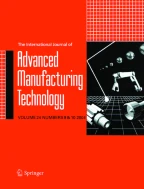Abstract
Flexible manufacturing systems are complex, stochastic environments requiring the development of innovative, intelligent control architectures that support flexibility, agility, and reconfigurability. Distributed manufacturing control system addresses this challenge by introducing an adaptive production control approach supported by the presence of autonomous control units that are cooperating with each other. Most of the currently distributed control systems still suffer from lack of flexibility and agility when the product verity is high and is not reconfigured in case of ad hoc events. To overcome this limitation, a drawback of an excessive dependence on up-to-date information about the products and other elements that move within the system is essential. Radio frequency identification (RFID) is a new emerging technology which uses radio frequency waves to transfer data between a reader and movable item for identification, tracking, and categorization purpose. This paper discusses the architecture devised to deploy RFID-enabled distributed control and monitoring system by means of a set of agents that are responsible for the realization of different control and monitoring tasks and for cooperating to enhance agility, flexibility, and reconfigurability of manufacturing system.
Similar content being viewed by others
References
Barenji VA, Barenji VR, Hashemipour M (2013) Structural modeling of a RFID-enabled reconfigurable architecture for a flexible manufacturing system. ITG-Fachbericht-Smart SysTech 2013.
Sikora R, Shaw MJ (1998) A multi-agent framework for the coordination and integration of information systems. Management Science 44(11-Part-2):S65–S78
Kouiss K, Pierreval H, Mebarki N (1997) Using multi-agent architecture in FMS for dynamic scheduling. J Intell Manuf 8(1):41–47
Ouelhadj D, Hanachi C, Bouzouia B (2000) Multi-agent architecture for distributed monitoring in flexible manufacturing systems (FMS). In Robotics and Automation, 2000. Proceedings. ICRA‘00. IEEE International Conference on (Vol. 3, pp. 2416–2421). IEEE.
Li X, Geng T, Yang Y, Xu X (2002) Multiagent AGVs dispatching system using multilevel decisions method. In American Control Conference, 2002. Proceedings of the 2002 (Vol. 2, pp. 1135–1136). IEEE.
Yamamoto H, Marui E (2005) Intelligent communication between agents of autonomous decentralized FMS. In Computational Intelligence in Robotics and Automation, 2005. CIRA 2005. Proceedings. 2005 I.E. International Symposium on (pp. 433–438). IEEE.
Reaidy J, Massotte P, Diep D (2006) Comparison of negotiation protocols in dynamic agent-based manufacturing systems. Int J Prod Econ 99(1):117–130
Leitao P (2009) Agent-based distributed manufacturing control: a state-of-art survey. Eng Appl Artif Intell 22:979–991
McFarlane D, Sarma S, Chirn JL, Wong CY, Ashton K (2003) Auto ID systems and intelligent manufacturing control. Eng Appl Artif Intell 16(4):365–376
Wang J, Luo Z, Wong EC (2010) RFID-enabled tracking in flexible assembly line. Int J Adv Manuf Technol 46(1–4):351–360
Lu BH, Bateman RJ, Cheng K (2006) RFID enabled manufacturing: fundamentals, methodology and applications. International Journal of Agile Systems and Management 1(1):73–92
Wang B, Cao Z, Yan Y, Liu W, Wang Z (2011) Fundamental technology for RFID-based supervisory control of shop floor production system. Int J Adv Manuf Technol 57(9–12):1123–1141
Pétin JF, Gouyon D, Morel G (2007) Supervisory synthesis for product-driven automation and its application to a flexible assembly cell. Control Eng Pract 15(5):595–614
Qiu RG (2007) RFID-enabled automation in support of factory integration. Robot Comput Integr Manuf 23(6):677–683
Chen RS, Tu MA, Jwo JS (2010) An RFID-based enterprise application integration framework for real-time management of dynamic manufacturing processes. Int J Adv Manuf Technol 50(9–12):1217–1234
Liu MR et al (2005) An RFID-based distributed control system for mass customization manufacturing. Parallel and distributed processing and applications. Springer, Berlin, pp 1039–1049
Satoh I (2006) Location-based services in ubiquitous computing environments. Int J Digit Libr 6(3):280–291
García A, Chang Y, Abarca A, Oh C (2007) RFID enhanced MAS for warehouse management. Int J Logist 10(2):97–107
Zhang Y et al (2011) Agent-based smart objects management system for real-time ubiquitous manufacturing. Robot Comput Integr Manuf 27(3):538–549
Liu WN et al (2012) RFID-enabled real-time production management system for Loncin motorcycle assembly line. Int J Comput Integr Manuf 25(1):86–99
Jun H-B et al (2009) A framework for RFID applications in product lifecycle management. Int J Comput Integr Manuf 22(7):595–615
Dai Q et al (2012) Radio frequency identification-enabled real-time manufacturing execution system: a case study in an automotive part manufacturer. Int J Comput Integr Manuf 25(1):51–65
Guerra-Zubiaga DA, Young RIM (2008) Design of a manufacturing knowledge model. Int J Comput Integr Manuf 21(5):526–539
Finkenzeller K (1999) RFID handbook: radio-frequency identification fundamentals and applications. Wiley, New York
Krothapalli NKC, Deshmukh AV (1999) Design of negotiation protocols for multi-agent manufacturing systems. Int J Prod Res 37(7):1601–1624
Giret A, Vicente B (2006) From system requirements to holonic manufacturing system analysis. International Journal of Production Research 44(18–19):3917–3928
Weng MX et al (2008) Multi-agent-based workload control for make-to-order manufacturing. Int J Prod Res 46(8):2197–2213
Barenji V, Reza MH, Guerra-Zubiaga DA (2013) Toward a modeling framework for organizational competency. Technological innovation for the Internet of things. Springer, Berlin, pp 142–151
Barenji RV (2013) Towards a capability‐based decision support system for a manufacturing shop. In Collaborative Systems for Reindustrialization (pp. 220–227). Springer, Berlin, Heidelberg
Nardi BA, Miller JR, Wright DJ (1998) Collaborative, programmable intelligent agents. Commun ACM 41(3):96–104
Author information
Authors and Affiliations
Corresponding author
Rights and permissions
About this article
Cite this article
Barenji, R.V., Barenji, A.V. & Hashemipour, M. A multi-agent RFID-enabled distributed control system for a flexible manufacturing shop. Int J Adv Manuf Technol 71, 1773–1791 (2014). https://doi.org/10.1007/s00170-013-5597-2
Received:
Accepted:
Published:
Issue Date:
DOI: https://doi.org/10.1007/s00170-013-5597-2
